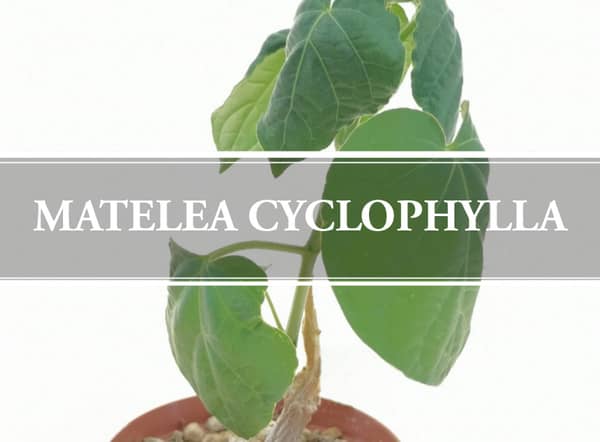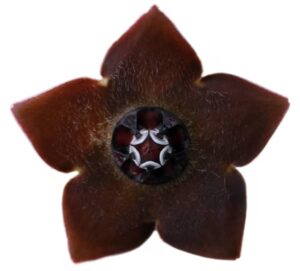Do we all not love to be surrounded with indoor perennials which not only add freshness to a room but also make our jaws drop by their exquisite beauty? Well, a very great example of such a plant is Matelea Cyclophylla which belongs to the genus Matelea and the family of Apocynaceae.
This plant stands out due to its striking appearance. It has gorgeous plants with tiny hairs that leave a matte look. This caudiciform is quite rare which is why it is high in demand and loved by many. Your interest can be seen developing in this species. Do you want to learn more about it? Keep reading to get wonder-stricken.
Matelea Cyclophylla Classification
Family: Apocynaceae
Subfamily: Asclepiadoideae
Tribe: Asclepiadaceae
Genus: Matelea
Genus Matelea:
In the family Apocynaeceas, Matelea is a genus of flowering plants. It comprises approximately 200 species which are all very different from each other. However, there is one similarity in all which is that all the plants have the shape of a flower.
A very interesting feature of them is that the flowers do not look like usual fragrant ones, they have a very unique, exquisite appearance. This makes people glue their eyes on them. ‘Milk vines’ is another term used while referring to this genus which was discovered in the early 1900s.
Features of the Matelea Cyclophylla Plant
Size:
This caudiciform plant can grow up to a height of 6 feet under a suitable environment. The growth is upright, in a climbing nature so the location of this plant should be decided according to that.
It is advised that this matelea should be provided with open space so that it can spread and take up the area available. The good news is that the growth is not at a very fast pace. This allows you to relocate the plant once you feel it will not be able to fit in its current space.
Leaves/stem description:
They have a fleshy appearance and grow up to 4 inches. Each plant has 1-2 deciduous vines that die annually and then regrow. That means this plant is not evergreen and leaves are shed in extreme temperatures or when there is a lack of care.
The striking feature of this Matalea is the flowers. Do you know what’s so unique about them? They have a pubescent surface with a ‘fuzz’ on them that gives a dull, curious look. They are found in deep burgundy or greenish-maroon color in the shape of a star with white edges.
These 2-2.5 cm flowers are usually hidden behind the foliage. The reproductive region is right in the center and pollination occurs with the assistance of flies. Fruits grow as a result of it usually has a single pod. They emit a scent that is not very strong but resembles the one of carrion.
Toxicity:
Do you have pets or children in your house? If yes, you have to be very careful. This Matelea seems beautiful but if ingested can cause major health issues. The entire plant has a poisonous, deadly chemical that can leave a drastic impact on one’s health.
There could be mild to very severe side effects in case of ingestion like swelling, inflammation, or death in the worst case. Well, this makes it pretty clear that you must maintain a friendly distance between you and Matelea cyclophylla. Warn your children to not unnecessarily touch the plant and you should also be very careful.
Other than this, like every other plant, this also has a high amount of bacteria on it which can cause infections. This is the major reason why it is advised to maintain the cleanliness of your plant to avoid such health problems. Despite that, the risk is still there. You must have heard ‘precaution is better than cure. Well, it’s time to implement that.
Pest/Disease Resistance:
Overall, there is no major risk of pest attacks on this plant. However, if you still feel that your plant is infected, isolate it and use proper insecticides. After all, you shouldn’t take any risk, right? But do not worry much. Just focus on providing the right care and everything will be good. The key to preventing any kind of bacterial growth is to keep the plant clean and dust-free.
Dormancy:
Matelea cyclophylla has a dormant phase that begins after the growing season in winters. During this period, you should just focus on maintaining the plant’s health. How exactly? By focusing on hydration, humidity, and temperature. Extreme weather conditions can induce dormancy during other seasons as well.
Matelea Cyclophylla Care
 Taking care of matelea cyclophylla cannot be classified as an easy task. However, that does not mean that it is that hard that a beginner can not take care of it. If this is your first plant adoption and worried if you won’t be able to take its care, do not worry!
Taking care of matelea cyclophylla cannot be classified as an easy task. However, that does not mean that it is that hard that a beginner can not take care of it. If this is your first plant adoption and worried if you won’t be able to take its care, do not worry!
The care is specific but once you crack the code, it is not that hard. The demands aren’t high except for the basic ones. In fact, it can survive for years if provided with the right amount of attention at a minimal expense. Its high durability makes this expensive plant worth buying.
Have a glance at easy and quick guidelines for Matelea Cyclophylla care:
Water levels: Frequent watering
Light: Indirect/partial lighting
Humidity: Extremely low level
Fertilizer: During growing season- summer and spring
Let’s move forward to a detailed guide on how to take care of this Matelea:
Water requirements
During summers and springs when this plant is in a growth phase, it is advised to water it regularly to keep it well-hydrated. After every few days insert your fingers till your knuckles are in the soil and if it comes out wet, do not water. That means the plant is pretty hydrated and doesn’t require further water intake at that point.
Usually, during the dormancy period when the plant either maintains its health or dies to regrow later, there is no need to water it. Think for a second. Why would you want to water a plant that has leaves falling out, has a weak stem, and is on the verge of dying?
Hence, avoid frequent watering during winters. Are you curious about what will happen if you over-water it? Well, at first root rot will develop due to high moisture in the soil. Then, roots won’t be able to breathe or provide adequate nutrients to the soil, and eventually, the plant will die.
Light requirements
In terms of sunlight, you should make sure Matelea Cyclophylla is nowhere near direct sunlight. It is not adapted to endure the scorching sun rays that fall on the leaves. So how should the light source exactly be like? It is advised to place it in a well-lit, bright room which has plenty of daylight entering from windows. These Mateleas prefer indirect or partial sunlight falling on them.
Soil requirements
The foremost thing that you should focus on is that the soil should not retain extra moisture because that just spoils it. Extra water causes root rot as mentioned above which you should prevent at all costs.
You should never compromise on soil’s quality and make sure it is well-draining. Moreover, it is advised to maintain soil’s Ph between 5.6-6.5 for matelea’s healthy growth. This leafy friend demands porous soil which includes perlite, pumice, etc.
Temperature and humidity requirements
Matelea Cylcophylla does not have a friendly relation with a colder climate. It requires warm temperatures with no extremity in climates. As soon as winters arrive, do not forget to relocate your Cyclophyllas to an indoor, cozy spot. If the temperature falls below 30-35 degrees, there could be an adverse reaction to the plant’s health. Therefore, if needed, you should use an indoor heater or an air conditioner if it’s too hot.
In terms of humidity requirements, there is some bad news. These mateleas are sensitive to high air moisture levels. They are highly prone to root rot due to overhydration. Keep in mind that, unlike other plants, you do not need to mist these. The only exception is during dry days, where there is no possibility of rain. During such days, the maximum that you can do is take a cloth, damp it, and wipe the leaves.
If you are someone who uses artificial humidifiers indoors, stop right there. This plant doesn’t need any extra humidity in the air. If you live in a place that is not a tropical area and generally humidity is of low levels, that’s your great luck! The reason behind it is that you do not have to worry at all about humidity issues.
Fertilizer requirements
During the growing season, it is advised to invest in a high-quality fertilizer that boosts the growth of your matelea. The cheaper ones contain chemicals that can have a drastic effect on plant life, hence please avoid buying those.
Are you confused with which fertilizer should you buy? Go for the slow-release ones. Use it from time to time in a limited, moderate dose. Over-fertilizing can also have severe harm.
Repotting and Pruning requirements
As mentioned above, the growth of this plant is not at a very high pace. The advised period is 2 years for re-potting. Once you start observing that roots are struggling to come out of the pot, buy a new bigger one and re-pot. Also, do not forget that the new pot must contain drainage holes to avoid water retention problems.
As far as the plant’s cleanliness is concerned, just make sure the leaves are not under a layer of dust. Other than that, cut off all the vines, branches that die during springtime. This reduces the possibility of bacteria growing on plants and even prevents pests from attacking the plant.
Matelea Cyclophylla Propagation
Propagation can be done easily by the seed germination method. For a detailed guide, refer to the steps below:
- Take some seeds out of fully grown Cyclophylla. Wash and dry them.
- Take a pot with nutrient-rich soil and make a hole in it with your finger. Place seed in it.
- Provide suitable growing conditions (refer to the guide above)
- At first, you will see shoots developing. Later on, vines grow out in a climbing position. After that, you can see flowers growing with seeds in them that are used for propagation.
Related Posts:
Summary
Matelea cyclophylla is a very attractive statement plant that grows upwards and takes up any empty spot. Their burgundy flowers add an aesthetic element to any room they are kept in. It does not have high demands and stays happy with occasional watering, timely fertilization, and pruning.
They love being displayed in natural light but are also sensitive to sun rays directly falling onto them. Overall, Matelea is not a hassle to take care of, but you should focus on its specific needs to keep it healthy and happy.


